Analysis of Natural Groundwater Flowing into the Flow Field of In Situ Leaching Mining
Abstract
:1. Introduction
2. Materials and Methods
3. Case Study
3.1. The Background of the Study Area
3.2. Numerical Simulation of the Mining Areas
3.2.1. Model Generalizability
Aquifer System Generalizability
Boundary Condition Generalizability of Groundwater System
Source and Sink Generalizability
Solute Generalizability
3.2.2. Solution and Identification of the Numerical Simulation
Hydrodynamic Flow and Solute Transport Equation
Identification of the Model
3.3. Analysis of the “Flow Ratio of Groundwater” in the Mining Areas
3.3.1. The Flow Quantity of Injection Wells
3.3.2. The Position of the Filter
3.3.3. The Length of the Filter
4. Conclusions
Author Contributions
Funding
Data Availability Statement
Conflicts of Interest
References
- Zhu, Z.Q.; Luo, X.F.; Wang, X.W. In-Situ Leaching of Uranium Handbook; The Sixth Research Institute of Nuclear Industry: Hunan, China, 2000. [Google Scholar]
- Que, W.M.; Tan, Y.H.; Zeng, Y.J.; Wang, S.D. Geochemical Kinetics and Mass Transport of In-Situ Uranium Leaching; Atomic Energy Press: Beijing, China, 2002. [Google Scholar]
- Ding, J.H.; Zhou, D.L.; Ma, S.Z. The State-of-Art Trends of Development of Groundwater Modeling Software Abroad. Site Investig. Sci. Technol. 2002, 1, 37–42. [Google Scholar]
- Guo, X.D.; Tian, H.; Zhang, M.G.; Zhu, W.; Cui, J. Visual MODFLOW; GMS; FEFLOW Application Development of Groundwater Value Simulation Software in Our Country. Ground Water 2010, 32, 5–7. [Google Scholar]
- Mategaonkar, M.; Eldho, T.I. Simulation of groundwater flow in unconfined aquifer using meshfree point collocation method. Eng. Anal. Bound. Elem. 2011, 35, 700–707. [Google Scholar]
- Li, F.; Li, J.K.; Ma, Y.; Li, H.E.; Ji, G.Q.; Yuan, M. The research and application progress of numerical simulation on groundwater. J. Water Resour. Water Eng. 2018, 29, 99–104. [Google Scholar]
- Wang, S.; He, S.L.; Yuan, H.Y.; Ji, D.L.; Qi, Z.B. Research progress of groundwater simulation in mining area based on GMS application. Ground Water 2022, 44, 14–17. [Google Scholar]
- Lu, H.; Peng, H.; Xu, Z.D.; Matthews, J.C.; Wang, N.; Iseley, T. A feature selection–based intelligent framework for predicting maximum depth of corroded pipeline defects. J. Perform. Constr. Facil. 2022, 36, 04022044. [Google Scholar] [CrossRef]
- Qin, G.; Xia, A.; Lu, H.; Wang, Y.; Li, R.; Wang, C. A hybrid machine learning model for predicting crater width formed by explosions of natural gas pipelines. J. Loss Prev. Process Ind. 2023, 82, 104994. [Google Scholar] [CrossRef]
- Yabusaki, S.B.; Fang, Y.L.; Waichler, S.R. Building conceptual models of field-scale uranium reactive transport in a dynamic vadose zone-aquifer-river system. Water Resour. Res. 2008, 44, 853–863. [Google Scholar] [CrossRef]
- Li, G.J.; Wang, H.F.; Zhang, Y.; Zhang, B.; Xiao, Z.X. Application of Visual MODFLOW numerical simulation of groundwater to in-situ leaching of uranium. Uranium Min. Metall. 2011, 30, 1–5. [Google Scholar]
- Cao, F.B.; Lian, G.X. Simulation for radical transportation of sulfate during in-situ leaching uranium in a sandstone-type uranium deposit. In Progress Report on China Nuclear Science & Technology (Vol.4); Atomic Energy Press: Beijing, China, 2015; pp. 275–279. [Google Scholar]
- Regnault, O.; Lagneau, V.; Fiet, N. 3D Reactive Transport Simulations of Uranium in situ Leaching: Forecast and Process Optimization; Merkel, B.J., Arab, A., Eds.; Uranium Past and Future Challenges; Springer International Publishing: Cham, Switzerland, 2015; pp. 725–730. [Google Scholar]
- Chen, X.X. Numerical Simulation of In-Situ Leaching of Uranium by Acid Method Based on Reactive Solute Transport Theory. Ph.D. Thesis, East China University of Technology, Jiangxi, China, 2020. [Google Scholar]
- Zhang, T.; Yuan, L.; Yang, K.; Liu, Y.; Yu, X. Modeling of Multiphysical–Chemical Coupling for Coordinated Mining of Coal and Uranium in a Complex Hydrogeological Environment. Nat. Resour. Res. 2021, 30, 571–589. [Google Scholar] [CrossRef]
- Zhang, C.; Tan, K.X.; Xie, T.T.; Tan, Y.; Fu, L.; Gan, N.; Kong, L. Flow Microbalance Simulation of Pumping and Injection Unit in In Situ Leaching Uranium Mining Area. Processes 2021, 9, 1288. [Google Scholar] [CrossRef]
- Tan, K.X.; Wang, Q.L.; Hu, E.M.; Hu, K.G.; Zhou, Q. Multiple Processes Coupling and Reaction Front Propagation During In-Situ Leach Mining: 1. Theoretical Analyses. Uranium Min. Metall. 2005, 24, 14–18. [Google Scholar]
- Chen, L.; Tan, K.X.; Liu, J.; Xie, Y.S.; Huang, W.; Ma, Q. Characteristics of Leaching Kinetics of a Sandstone Uranium Deposit in Yili Basin. Met. Mine 2013, 3, 18–20. [Google Scholar]
- Simon, R.B.; Thiry, M.; Schmitt, J.M.; Lagneau, V.; Langlais, V.; Bélières, M. Kinetic reactive transport modelling of column tests for uranium In Situ Recovery (ISR) mining. Appl. Geochem. 2014, 51, 116–129. [Google Scholar] [CrossRef]
- Zuo, W.; Tan, K.X. The Characteristics of Groundwater Contamination of a Decommissioned Wellfield in Some in Situ Leaching Uranium Mine, Xinjiang, China. J. Univ. S. China 2014, 28, 28–34. [Google Scholar]
- Wang, X.D.; Wu, L.W.; Duan, B.S.; Xie, T.T.; Yang, L.Z.; Du, Z.M. Interwell tracer test in in-situ leaching uranium in one place of Xinjiang. Uranium Min. Metall. 2014, 33, 130–133. [Google Scholar]
- Zhou, Y.P.; Shen, Z.L.; Sun, Z.X.; Liu, J.H.; He, J.T. Application study on particle tracer technique to calculate the in-situ leaching area of uranium mining. China Min. Mag. 2015, 24, 117–120. [Google Scholar]
- Liu, Z.B.; Wang, H.F.; Wen, Z.Q.; Ding, Y.; Jiang, Y.; Xie, T.T.; Xu, G.L.; Wang, G. Study on the Characteristics of Solution Migration and Drawing and Injection Control at Well Field In-Situ Leaching Uranium. Uranium Min. Metall. 2017, 36, 23–26. [Google Scholar]
- Xie, T.T.; Ding, Y.; Zhou, G.M.; Xu, G.L.; Li, H.X.; Deng, J.X.; Zhang, C.; Xu, Z.H. Numerical Simulation Analysis of Homologous Tracing Data Before and After Acidification in the Conditional Experiment of an In-situ Leaching Uranium Mine. Uranium Min. Metall. 2018, 37, 1–8. [Google Scholar]
- Wang, H.F.; Guo, N.; Xie, T.T.; Li, G.J. The influence of groundwater dilution on pregnant solution of in-situ leaching of uranium. Uranium Min. Metall. 2012, 31, 9–13. [Google Scholar]
- Zhou, Y.P.; Shen, Z.L.; Sun, Z.X.; He, J.T.; Xing, Y.G. Study on the influence of pumping-injection equilibrium on outflow of leaching solution and inflow of groundwater during in-situ leaching of uranium. Nonferrous Met. 2013, 65, 1–4. [Google Scholar]
- Xie, T.T.; Yao, Y.X.; Gan, N.; Zhang, C.; Xu, G.L.; Wen, Z.Q. Analysis and application of seepage-dispersion field characteristics in-situ leaching uranium (to be continued). Uranium Min. Metall. 2016, 35, 149–158. [Google Scholar]
- Panfilov, M.; Uralbekov, B.; Burkitbayev, M. Reactive transport in the underground leaching of uranium: Asymptotic analytical solution for multi-reaction model. Hydrometallurgy 2016, 160, 60–72. [Google Scholar] [CrossRef]
- Greskowiak, J.; Prommer, H.; Liu, C.; Post, V.E.A.; Ma, R.; Zheng, C.; Zachara, J.M. Comparison of parameter sensitivities between a laboratory and field scale model of uranium transport in a dual domain, distributed rate reactive system. Water Resour. Res. 2010, 46, 4921–4933. [Google Scholar] [CrossRef]
- Xie, T.T.; Yao, Y.X.; Gan, N.; Zhang, C.; Xu, G.L.; Wen, Z.Q.; Peng, Y. Analysis and application of seepage-dispersion field characteristics in-situ leaching uranium (Complete). Uranium Min. Metall. 2016, 35, 229–239. [Google Scholar]
- Xu, Q. Study on Influence of the Ratio of Drawing-injection to In-situ Leaching Solution Diffusion Range. Uranium Min. Metall. 2017, 36, 93–97. [Google Scholar]
- Ji, H.B.; Huang, Q.Y.; Zhou, Y.P.; Zhang, Q.L. Influence of In-situ Leaching Solution Diffusion with Drawing Injection flux Distribution and Drawing Injection proportion. Uranium Min. Metall. 2017, 36, 172–181. [Google Scholar]
- Cao, Y.X.; Zuo, W.; Bao, Z.X.; Gu, P.; Ye, T. Practice and Exploring of Different Proportional Control of Drawing and Injection of Leaching Solution for the In-Situ Leaching Uranium and Its Impact on the Groundwater Environment. Uranium Min. Metall. 2017, 36, 134–143. [Google Scholar]
- Li, D.; Duan, B.S. Microscopic Equilibrium Optimization of Leaching Range in In-Situ Leaching Mining Field. Uranium Min. Metall. 2017, 36, 41–45. [Google Scholar]
- Zhang, C.; Xie, T.T.; Tan, K.X.; Yao, Y.X.; Wang, Y.A.; Li, C.G.; Li, Y.M.; Zhang, Y.; Wang, H. Hydrodynamic Simulation of the Influence of Injection Flowrate Regulation on In-Situ Leaching Range. Minerals 2022, 12, 787. [Google Scholar] [CrossRef]
- Huang, Q.F. Uranium Metallogenic Characteristics and Prospecting Direction in the BARUN Area, The Left County Sunite, Inner Mongolia; Jilin University: Jilin, China, 2018. [Google Scholar]
- Chen, C.X.; Tang, Z.H. The Numerical Methods of Ground Water Flow; China University of Geosciences Press: Hubei, China, 2009. [Google Scholar]
- Zheng, C.M.; Bennett, D.G. Applied Contaminant Transport Modeling, Second Edition; Wiley Interscience: Hoboken, NJ, USA, 2002. [Google Scholar]
- Wang, Y.H.; Xia, A.L.; Qin, G.J. Probabilistic modeling for reliability analysis of buried pipelines subjected to spatiotemporal earthquakes. Probabilistic Eng. Mech. 2022, 69, 103315. [Google Scholar] [CrossRef]
- Wang, Y.H.; Xia, A.L.; Zhang, P.; Qin, G.J. Probabilistic physical modeling of randomly corroded surface and its use in reliability analysis of corroded pipelines under spatiotemporal vibration. Ocean Eng. 2022, 262, 112219. [Google Scholar] [CrossRef]
- Dell, A.D.; Bersezio, R.; Felletti, F.; Giudici, M.; Comunian, A.; Renard, P. Comparison of three geostatistical methods for hydrofacies simulation: A test on alluvial sediments. Hydrogeol. J. 2012, 20, 299–311. [Google Scholar]
- Sun, Q. Improvement and Application of Groundwater Flow Stochastic Simulation Method based on T-PROGS; China University of Geosciences (Beijing): Beijing, China, 2019. [Google Scholar]
- He, Z. Numerical Simulation of Uranium Mine Based on GMS; University of South China: Hunan, China, 2016. [Google Scholar]
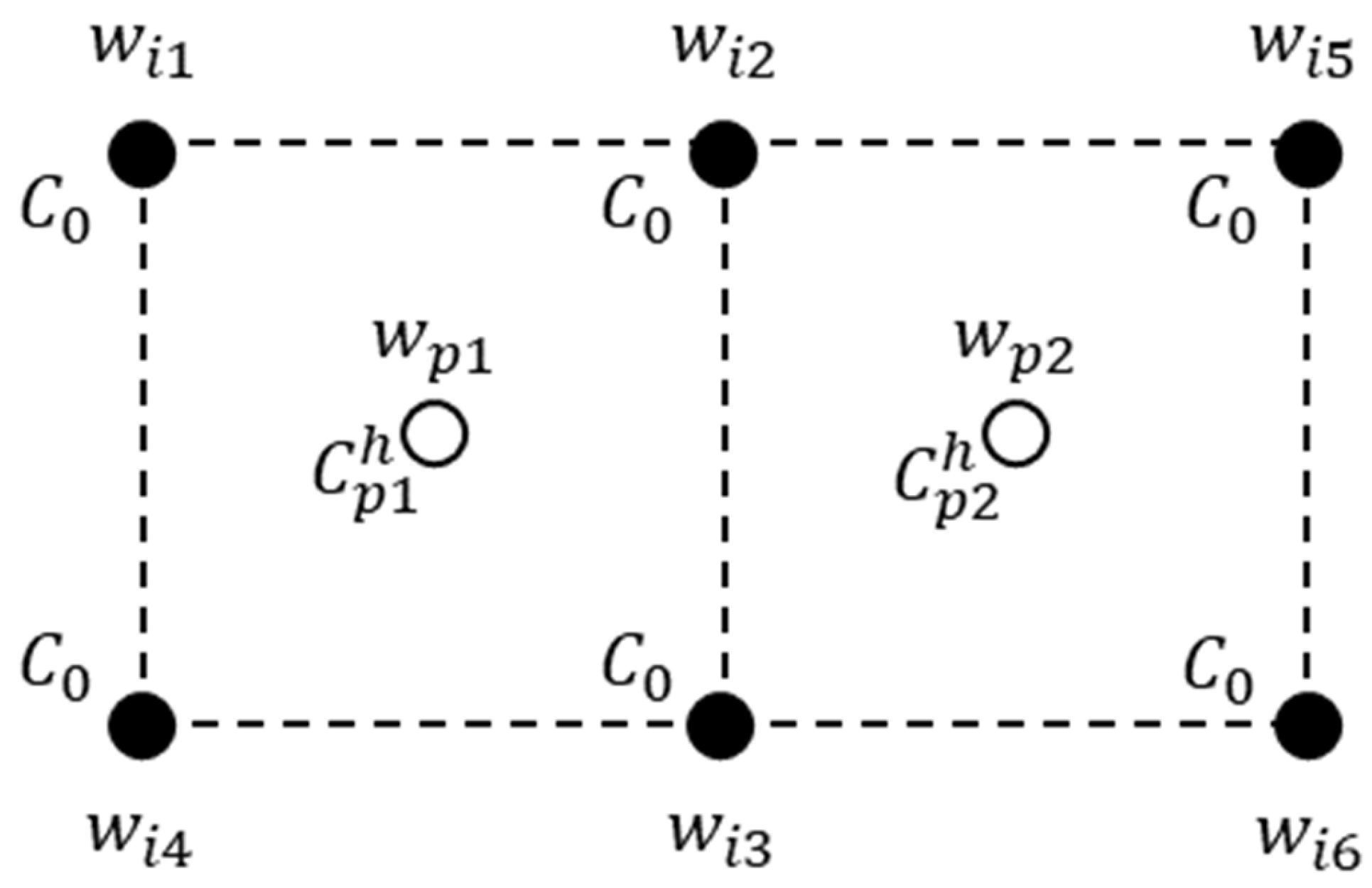





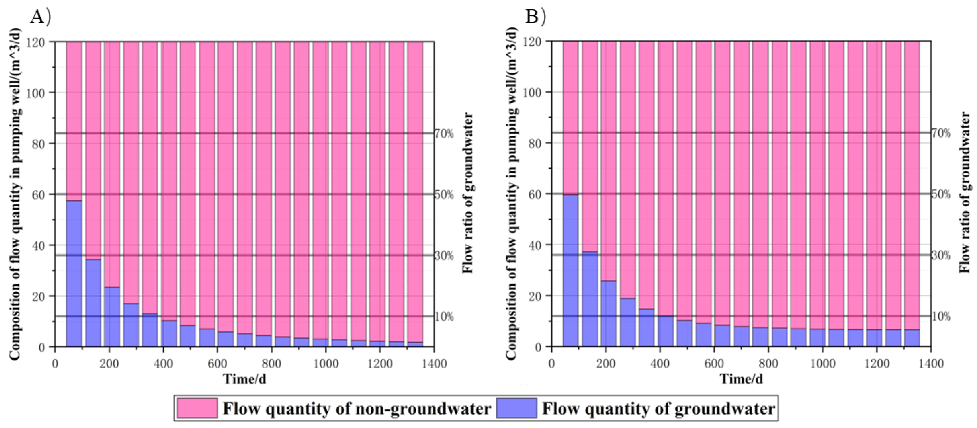
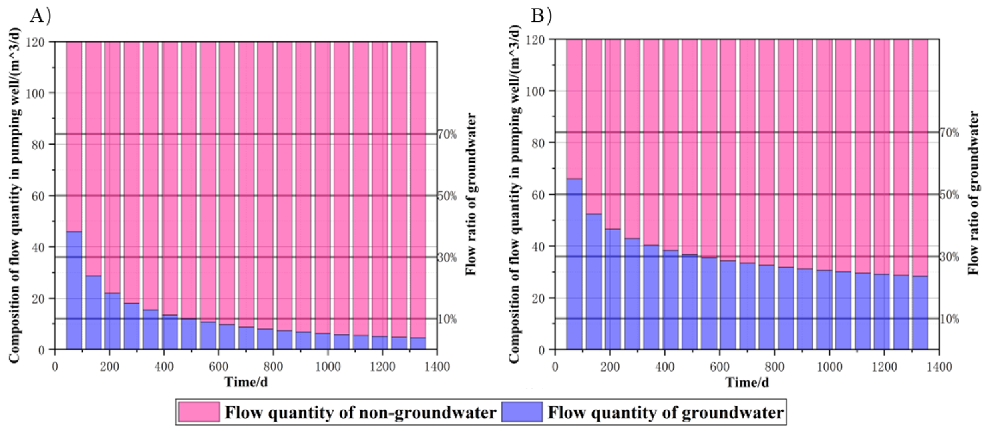
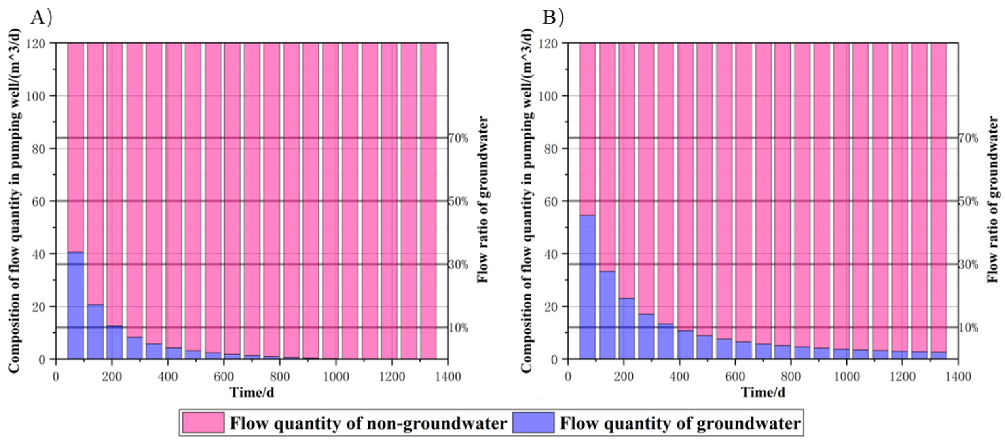

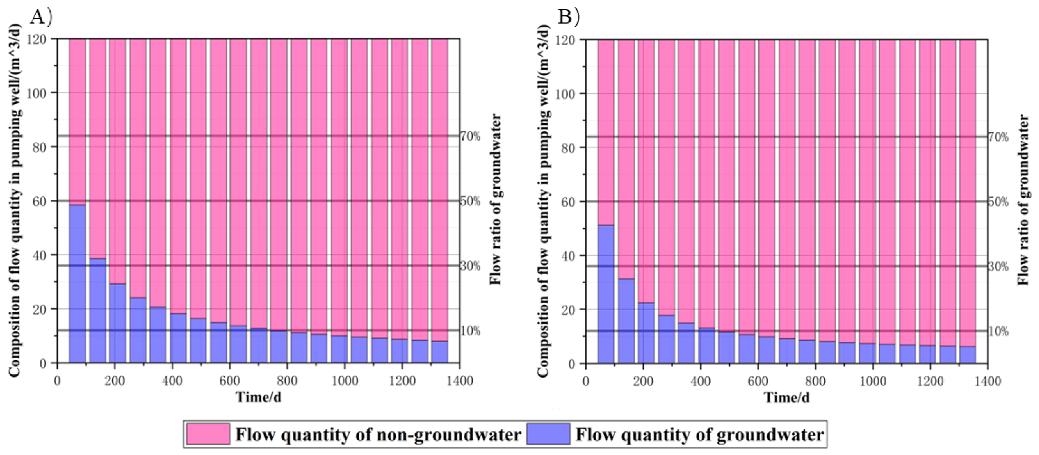
| Flow Ratio of Groundwater | 70% | 50% | 30% | 10% | ||
|---|---|---|---|---|---|---|
| Arrival Time (Day) | ||||||
| Plan | ||||||
| Plan A | 29 | 66 | 147 | 561 | ||
| Plan B | 37 | 89 | 230 | 1318 | ||
| Flow Ratio of Groundwater | 70% | 50% | 30% | 10% | ||
|---|---|---|---|---|---|---|
| Arrival Time (Day) | ||||||
| Plan | ||||||
| Plan A | 29 | 66 | 147 | 561 | ||
| Plan C | 25 | 55 | 117 | 324 | ||
| Flow Ratio of Groundwater | 70% | 50% | 30% | 10% | ||
|---|---|---|---|---|---|---|
| Arrival Time (Day) | ||||||
| Plan | ||||||
| Plan D | 30 | 66 | 154 | 758 | ||
| Plan E | 25 | 53 | 116 | 469 | ||
Disclaimer/Publisher’s Note: The statements, opinions and data contained in all publications are solely those of the individual author(s) and contributor(s) and not of MDPI and/or the editor(s). MDPI and/or the editor(s) disclaim responsibility for any injury to people or property resulting from any ideas, methods, instructions or products referred to in the content. |
© 2023 by the authors. Licensee MDPI, Basel, Switzerland. This article is an open access article distributed under the terms and conditions of the Creative Commons Attribution (CC BY) license (https://creativecommons.org/licenses/by/4.0/).
Share and Cite
Li, Q.; Li, Z.; Xie, T.; Ding, Y.; Gan, N.; Tan, Y.; Zhang, C. Analysis of Natural Groundwater Flowing into the Flow Field of In Situ Leaching Mining. Processes 2023, 11, 471. https://doi.org/10.3390/pr11020471
Li Q, Li Z, Xie T, Ding Y, Gan N, Tan Y, Zhang C. Analysis of Natural Groundwater Flowing into the Flow Field of In Situ Leaching Mining. Processes. 2023; 11(2):471. https://doi.org/10.3390/pr11020471
Chicago/Turabian StyleLi, Qinci, Zhaokun Li, Tingting Xie, Ye Ding, Nan Gan, Yahui Tan, and Chong Zhang. 2023. "Analysis of Natural Groundwater Flowing into the Flow Field of In Situ Leaching Mining" Processes 11, no. 2: 471. https://doi.org/10.3390/pr11020471
APA StyleLi, Q., Li, Z., Xie, T., Ding, Y., Gan, N., Tan, Y., & Zhang, C. (2023). Analysis of Natural Groundwater Flowing into the Flow Field of In Situ Leaching Mining. Processes, 11(2), 471. https://doi.org/10.3390/pr11020471










